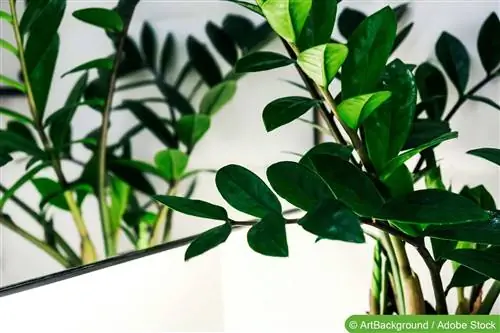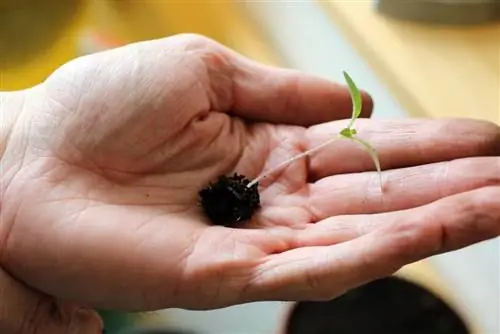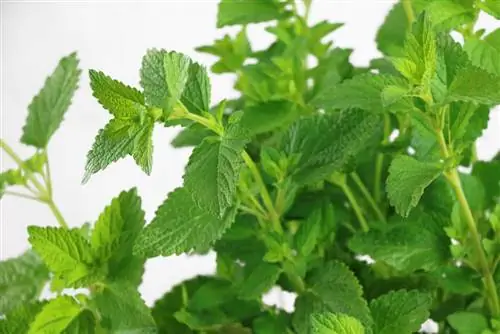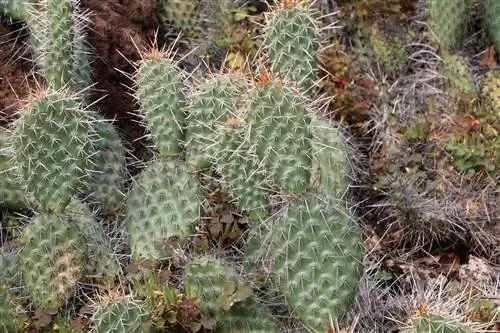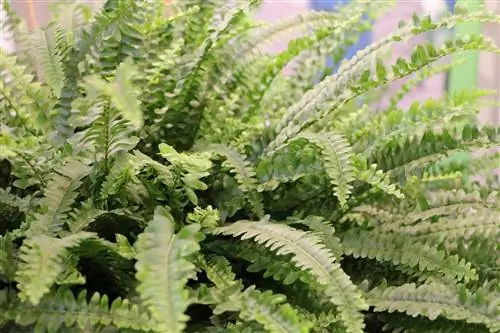- Author admin [email protected].
- Public 2023-12-17 03:39.
- Last modified 2025-01-24 12:45.
Many houseplants only thrive if they get enough light, so they need a bright location with as direct sunlight as possible to develop their splendor. But there are also a whole range of plants that don't tolerate this well.
Most of them originally come from tropical or subtropical forests. There they usually grow close to the ground, where there is little light. This makes them suitable for darker rooms or hallways, they can stand further away from the window and also feel very comfortable in the shade of their sun-hungry relatives.
Plants that fill spaces
Most houseplants that thrive on little light bloom very inconspicuously or not at all. They prefer to display their splendor through the delicate shapes and colors of the foliage. Some of them are extremely large and room-filling:
- The indoor fir (botanical name: Araucaria) is a conifer that usually does not grow larger than 1.80 meters, but can also grow up to three meters high under very good conditions. The easy-care solitary plant likes it bright, but it cannot tolerate direct sun.
- The dragon tree (Dracaena) can also grow to 1.5 to 2.5 meters high. It is very popular because of its narrow, pointed, colorful leaves and palm-like growth habit. It comes in many different varieties, all of which are easy to care for. However, most people prefer temperatures of 19 to 25 °C.
Other tall-growing houseplants that like their existence in the shade or at least tolerate it well: the Kentia palm (Howea), the tree friend (Philodendron) and the radiant aralia (Schefflera aboricola).
Plants with leaf decorations that fit anywhere
If you are looking for slightly smaller plants, e.g. If, for example, there is enough space on a chest of drawers, then you could choose cardamom (Elletaria). This spice plant, which comes from India, belongs to the ginger family. It forms strong roots just below the surface of the earth, from which new shoots 50-70 cm high with pointed, oval, green leaves grow. The cardamom does not require high levels of care and its capsule fruits can also be used in the kitchen. The following are also considered very robust plants with decorative green foliage:
- The cobbler palm (Aspidistra) and the lucky feather (Zamioculcas). Both are very undemanding, can grow up to 70 or 90 cm high, and also thrive in the shade.
- The cornice (Scirpus), a pretty evergreen perennial grass, is very easy to care for, thrives on little light and grows well in a window on the north side.
- Alocasia, on the other hand, requires significantly more attention from its owner. The large, heart-shaped, oval-shaped leaves impress with their darker green veins. The sensitive ornamental plants attach great importance to consistent soil moisture. In addition, they cannot tolerate temperatures below 18 °C.
- The arrowroot (Calathea), which grows to a height of 15-30 cm, also attaches great importance to a uniform moisture level. It is best to use rainwater for watering, as this plant does not tolerate lime.
- The delicate slingshot flower (Pilea) forms pretty silvery spots on its oval leaves on a green background and can be easily combined with other plants in bowls or pots. They react particularly sensitively to waterlogging.
- Dieffenbachia, on the other hand, with its fleshy, soft leaves, feels very comfortable in partial shade, but attaches great importance to high humidity.
Blooming beauties in low light
In order to produce colorful flowers, most plants need a lot of brightness and direct sun. A few people manage to do this even in dim light. However, the rotary fruit (Streptocarpus) cannot do without it. There are many different varieties of the 20-40 cm tall ornamental plant, whose flowers cover a color spectrum from white to dark blue. They all thrive best in a medium-light location without direct sunlight. You should use low-lime rainwater for watering. The piston thread (Aglaonema commutatum), which is more valued for its effectively patterned leaves, also produces an attractive inflorescence in late summer. However, the resulting berries are poisonous. In autumn, the easy-care Siderasis fuscata also produces delicate flowers in violet-blue to red-violet colors on hairy stems. Both types of plants do not grow too tall and are easy to cultivate indoors. Things are a little more difficult with the Rohdea plant, which tends to get too warm in the room.
While all of the species mentioned so far bloom rather inconspicuously and only for a relatively short time, the flamingo flower impresses with its extremely beautiful and long-lasting flowers. The bracts on the shaft of the flower spadix shine in white, salmon red or dark red, while the leathery arrow-shaped leaves are colored dark green. Under good conditions it can grow up to 1 m high. The elegant partial shade plants don't like direct sun, but it can be bright, otherwise their leaves will become sparse and long. They also value lime-free water and high humidity.
Traffic plants in low light
Some of the plants that survive in low light also do very well in hanging baskets. The ivy (Epipremnum) forms long shoots with yellow and green colored heart-shaped leaves. The meter-long shoots of the climbing plant are ideal for adding greenery to walls, trellises and wooden beams. In low light conditions the leaves lose some of the bright marbling but still retain a rich green tone. The ivy is very adaptable, but feels most comfortable in humid air. The small evergreen (Vinca) forms shoots that can be up to 2 m long, are densely covered with small green leaves, and hang decoratively in hanging baskets. Small, light blue flowers grow on the leaf axils. The plants like a well-ventilated and rather cool location, but are otherwise relatively easy to care for. Also suitable as hanging plants are the pubic flower (Aeschynanthus), with its attractive red flowers, and the diligently climbing clime (Cissus).
Ferns
Some subtropical fern species can also be cultivated very well indoors. Since they are originally native to shady forest floors, it stands to reason that they can also thrive in rooms with little light. The striped fern (Asplenium), the moss weed (Selaginella), the deer's-tongue fern (Phyllitis), the spotted fern (Phlebodium) and the hare's-foot fern (Davallia) come into question. The ferns are all relatively easy to care for.
What you need to know about plants for rooms with little light
If you live in an apartment with little sunlight, you don't have to forego the pleasant atmosphere created by green plants. Although lush flowers are rare, many of the shade-loving plants have delicate leaf shapes and patterns. In addition, most are relatively frugal and easy to care for.
For some houseplants, a shady place is important in order to feel comfortable. They provide fresh greenery in low-light rooms all year round. There is something for everyone among the easy-care all-rounders. In the dry heating air, you should ensure sufficient humidity for the sake of the plants. Water bowls on the radiators or an indoor fountain help a lot. Water sparingly with water at room temperature
- Ivy plant: The popular climbing plant is suitable for hanging baskets as well as for hydroponics
- Chestnut wine: The climbing plant tolerates dry room air and hard water
- Cob thread: Its oval leaves have an attractive silver pattern
- Radiant Aralia: With green and colorful leaves, spotted leaves provide color accents
- African Violet wants to stay warm all year round, keep it moderately moist, water less in winter
- Single leaf needs warmth and moist air, water and spray with low-lime water
- Ornamental asparagus does not like overheated rooms, it is essential to avoid waterlogging and cold feet
- Green lily undemanding, tolerates high temperatures, water abundantly, but never keep it too wet
- Spray often when the temperature is high, keep slightly moist, water only a little in winter
As long as there are no dense trees or high walls blocking daylight, windows on the north, northwest or northeast side of a house offer the best conditions for all shade plants. This also includes residents of the tropical rainforest. Since they are sensitive to cold, you have to be particularly careful in winter that the room temperature does not drop too much at night. Otherwise, caring for the potted plants here is easy. On sunny days you can avoid shading and only need to water at longer intervals. Because of the low water consumption, as a precaution, always check the moisture of the pot ball before using the watering can. Wet feet are particularly dangerous at low temperatures.

